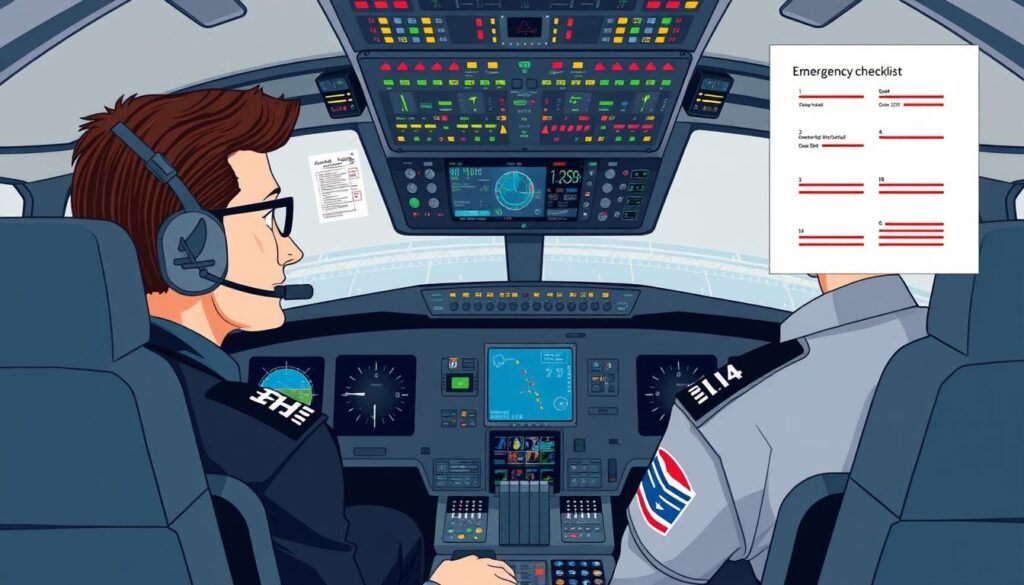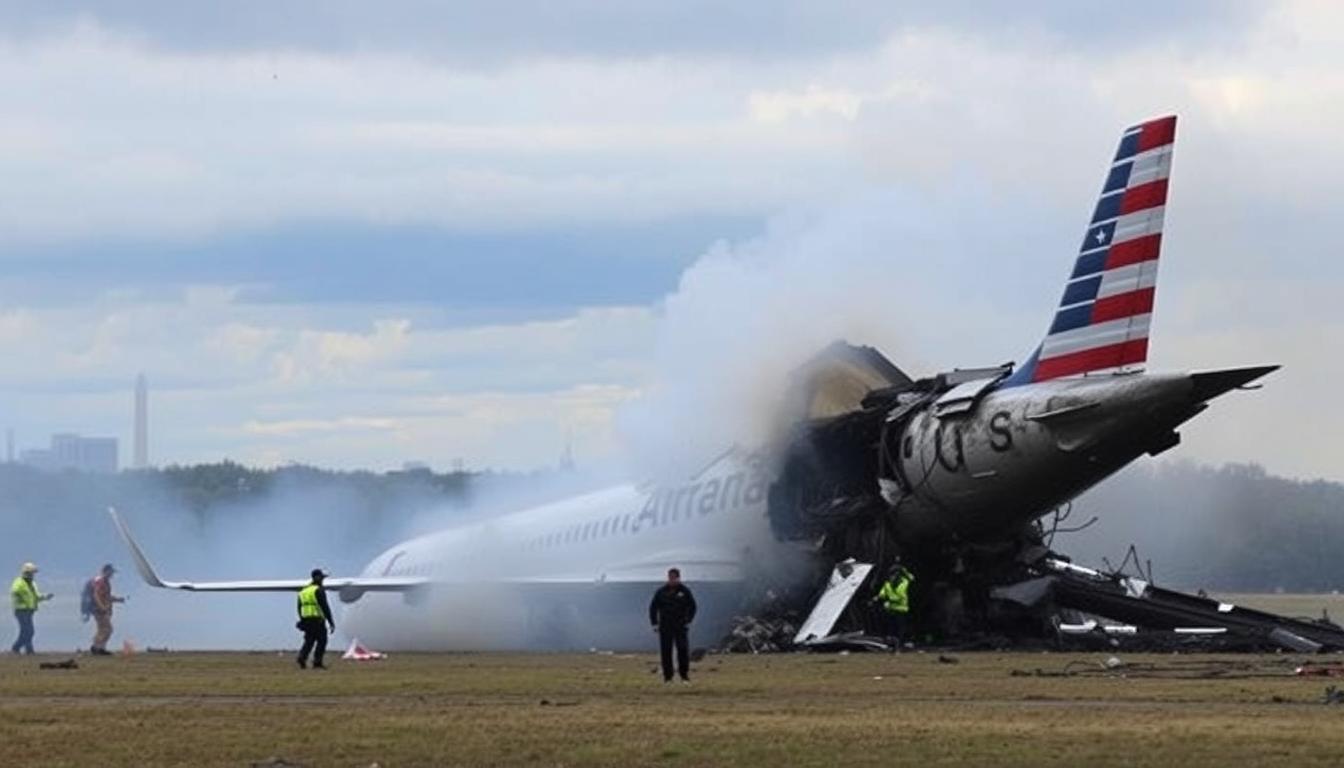I’m sharing the latest news on the American Airlines plane crash in Washington DC. An American Airlines jet with 60 passengers and four crew members crashed into a military helicopter. This happened while the plane was landing at Ronald Reagan National Airport1.
The crash happened when the plane was cleared to land at 400 feet and 140 miles per hour1. Emergency services quickly responded, with about 300 first responders helping1.
The crash has also closed Ronald Reagan National Airport until 5 a.m. Friday1. It’s the first major fatal crash in the U.S. in 2009, with 50 fatalities1. The Potomac River was 36 degrees Fahrenheit, with wind gusts up to 25 mph1.
The crash has raised concerns about air travel safety. It’s the first deadly incident in a U.S. commercial airline in 20092. Nearby airports are also affected, with flights going to Dulles International Airport, 28 miles away3.
Key Takeaways
- The american airlines plane crash in washington dc resulted in a significant response from emergency services.
- Around 300 first responders participated in the rescue operation1.
- The incident has affected the operations of Ronald Reagan National Airport.
- The conditions in the Potomac River were reported at 36 degrees Fahrenheit1.
- The crash marks the first deadly incident involving a US commercial airline in 20092.
- Flights are being diverted to Dulles International Airport3.
Breaking: Who Was on the American Airlines Plane That Crashed in Washington?
The crash of an American Airlines plane in Washington has raised big concerns about air travel safety. The plane had 60 passengers and 4 crew members4. It was carrying athletes, coaches, and family members back from a U.S. Figure Skating Championships event4.
The crew included 2 pilots and 2 flight attendants4. Emergency teams quickly arrived, with about 300 responders and divers helping in the search5. The Potomac River’s water was just 37 degrees Fahrenheit, which is very cold6.
The following table provides an overview of the american airlines plane crash:
| Category | Number |
|---|---|
| Passengers | 60 |
| Crew Members | 4 |
| First Responders | 300 |
An investigation is underway to find out why the plane crashed4. The crew’s actions will also be looked into to see if they made any mistakes5.
The Incident at Ronald Reagan Washington National Airport
An American Airlines regional jet, operated by PSA Airlines, hit a Black Hawk helicopter at Ronald Reagan Washington National Airport7. This was the first major crash in the U.S. in over 13 years7. The accident happened as the jet was trying to land around 9 p.m. ET8.
About 300 first responders helped in the search and rescue8. The Potomac River’s water depth at the site was about 8 feet8.
Ronald Reagan Airport was once called Washington National Airport, renamed in 19987. It’s a big hub for American Airlines. The accident happened when an American Airlines jet crashed into a military helicopter while landing7.
The flight from Wichita, Kansas to Washington, D.C. started about a year before the crash7. It began daily service on January 8, 20247.
Some important facts about the incident include:
- 64 people were on the regional jet that crashed8
- 63 were American citizens8
- The last major commercial airplane accident in the U.S. was in 2009, with 50 fatalities8
The incident is seen as the most significant disaster in U.S. airspace in at least 15 years8. Ronald Reagan Washington National Airport was closed until at least 11 a.m. ET the next day8. The crash at Ronald Reagan Washington National Airport shows how critical aviation safety and crisis response are7.
Flight Details and Route Information
The American Airlines plane that crashed in Washington was flying from Wichita, Kansas to Washington, D.C9.. The flight details and route information are key to understanding the crash. The plane was set to land at Ronald Reagan National Airport10.
The flight was a regional one, run by PSA Airlines. It had 68 to 73 seats for passengers10. Knowing where it started and where it was going helps figure out why it crashed. The weather was clear, with no bad weather reported9.
Here is a summary of the flight details:
- Origin: Wichita, Kansas
- Destination: Washington, D.C.
- Airline: American Airlines
- Flight number: 5342
- Aircraft type: Bombardier CRJ700 regional jet
The crash is being looked into, and the NTSB is trying to find out why it happened9. They will check the flight’s details, route, and more to figure out the cause.
| Flight Details | Information |
|---|---|
| Origin | Wichita, Kansas |
| Destination | Washington, D.C. |
| Airline | American Airlines |
Historical Context of Ronald Reagan Airport Operations
Ronald Reagan Washington National Airport has a long history of safe operations. It focuses on the highest standards of safety and efficiency11. The airport has seen many events, like new aircraft and facility expansions12. It’s one of the busiest airports, following strict noise and safety rules for everyone’s well-being13.
The airport handles a lot of flights, with airlines like American Airlines11. It has a good safety record, with only a few incidents in recent years12. But, the recent accident with an American Airlines jet and a US Army helicopter shows the need for top safety standards13.
| Airport | Incidents | Safety Record |
|---|---|---|
| Ronald Reagan Washington National Airport | Few incidents reported | Impressive safety record |
Ronald Reagan Airport is a complex place, with many runways and terminals11. Its history includes new aircraft and bigger facilities12. It’s one of the busiest airports, with strict rules for noise and safety13.
American Airlines Safety Record and Previous Incidents
American Airlines has a solid safety record, with only a few incidents in recent years14. The airline has lost almost sixty planes in its history, starting in 193115. Most of these losses were propeller-driven planes, like the Lockheed L-188 Electra15.
The U.S. went over 15 years without a major air disaster at a U.S. airline before this recent incident14. American Airlines has faced 17 hijacking incidents, including two on 9/1115. The airline has a plan for emergencies and is fully cooperating with the crash investigation.
Here is a summary of American Airlines’ safety record:
- Almost sixty aircraft hull losses in history15
- 17 hijacking incidents involving its flights15
- Good safety record, with few incidents in recent years14
The airline’s safety record shows its dedication to safety and efforts to avoid accidents. American Airlines always puts the safety of passengers and crew first. Its past incidents have led to better safety measures1415.
| Year | Incident | Fatalities |
|---|---|---|
| 1931 | Ford 5-AT-C Trimotor crash | 6 |
| 1931 | Pilgrim 100A crash | 4 |
| 1932 | Fokker F-10A crash | 7 |
Impact on Washington D.C. Air Traffic
The crash of the American Airlines plane in Washington D.C. has had a big impact on air traffic in the area16. The accident happened near Reagan National Airport, one of the busiest airports in the U.S16.. The airport was shut down until at least 11 a.m. on the next Thursday17.
Flights at Reagan National were grounded from the time of the crash on Wednesday night to Thursday morning17.
The air traffic in Washington D.C. has been badly disrupted, with many flights delayed or canceled18. The crash has also made people worry about the safety of flying in the area. The Traffic Collision Avoidance System (TCAS) usually warns pilots above 700 feet. But, the crash happened too low for it to work16.
It’s being seen as one of the worst disasters in Washington in the last decade, unofficial reports say18.
Here are some key facts about the crash and its impact on Washington D.C. air traffic:
- The crash happened around 9 p.m. Eastern Time on Wednesday17.
- The plane was just “a few hundred feet off the ground” when the crash occurred17.
- At least 18 bodies were found at the crash site, with no survivors17.
- The search area had 5-8 feet of water depth where the plane wreckage was located17.
The crash has had a big impact on Washington D.C. air traffic, with many flights delayed or canceled18. It has also made people worry about flying safety in the area. As the investigation goes on, it’s important to think about the long-term effects on Washington D.C. air traffic16.
American Airlines’ Position as a Major Carrier
American Airlines is one of the largest airlines globally, with over 900 aircraft in its fleet19. It is a major player in the aviation world. The airline serves the US market well, thanks to its extensive route network and large fleet.
It operates over 6,700 flights daily, serving millions of passengers20. This shows its huge impact on the US aviation scene. American Airlines is a leading airline, thanks to its operations and fleet size.
The airline’s passenger numbers are impressive, with millions flying with it each year19.
Some key facts about American Airlines’ operations include:
- Over 900 aircraft in its fleet19
- Over 6,700 flights operated per day20
- One of the largest airlines in the world in terms of fleet size and passenger volume19
American Airlines’ status as a major carrier comes from its large fleet and extensive operations. Its ability to run many flights daily has boosted its success and popularity. As a major carrier, American Airlines remains a key player in the US aviation industry20.
Standard Flight Crew Protocols and Requirements
Flight crew protocols and requirements are key to air travel safety. They ensure the safety of everyone on board. Flight crews must follow strict rules for pre-flight checks, in-flight monitoring, and post-flight procedures21. These rules help them be ready for any situation during the flight.
Flight crew members must get regular training and simulator exercises. This training helps them handle emergencies well, like the American Airlines crash in Washington22. They also have to follow strict guidelines and regulations.
The longest flight in the world is tough for flight crew. They must stay alert and focused the whole time21. Airlines help by rotating crew and giving them breaks. Crew members also get regular medical checks to make sure they’re fit to fly.
Some important protocols and requirements for flight crew include:
- Pre-flight checks to ensure the aircraft is airworthy
- In-flight monitoring to detect any issues
- Post-flight procedures to secure the aircraft
- Regular training and simulator exercises
- Following strict guidelines and regulations

By following these protocols, flight crew members keep everyone safe, even in emergencies22. As the aviation world changes, it’s vital for flight crew to stay current with safety protocols.
Emergency Response Procedures at Major US Airports
Major US airports have emergency plans ready for quick action in case of an incident23. These plans help first responders, get people out safely, and give medical help. The aim is to lessen the impact and keep everyone safe.
Emergency teams at big US airports are ready for many situations, like plane crashes23. They have the right tools and training for fast and effective action. These plans are checked and updated often to stay sharp.
First Responder Coordination
Working together with local emergency teams is key at major US airports23. This teamwork ensures a quick and strong response to emergencies. It’s vital for getting the right help to the scene fast.
Evacuation Protocols
Evacuation plans are also critical at major US airports23. They help get people out of planes quickly and safely in emergencies. These plans are practiced and updated to work well.
| Emergency Response Procedure | Description |
|---|---|
| First Responder Coordination | Coordinating with local emergency services to respond to an incident |
| Evacuation Protocols | Evacuating passengers and crew from an aircraft in the event of an emergency |
The emergency plans at major US airports are made for quick and effective action23. By working with first responders and having evacuation plans, airports can reduce the impact of incidents. This ensures the safety of everyone involved.
Washington D.C. Aviation Infrastructure
The aviation infrastructure in Washington D.C. is well-developed, with three major airports in the area24. These airports have modern facilities and are staffed by experienced people. Washington D.C. plays a big role in the aviation industry.
Some key facts about the aviation infrastructure in Washington D.C. include:
- Reagan National Airport is one of the busiest airports in the country25
- The airport focuses a lot on safety and security, with advanced systems to protect passengers25
- The aviation infrastructure in Washington D.C. is supported by organizations like the Federal Aviation Administration (FAA)24
Overall, the aviation infrastructure in Washington D.C. is key to the city’s economy and transportation. With its well-developed airports and focus on safety, Washington D.C. is a major air travel hub in the United States25.
| Airport | Location | Passenger Volume |
|---|---|---|
| Reagan National Airport | Washington D.C. | 23 million |
| Dulles International Airport | Chantilly, VA | 60 million |
| Baltimore-Washington International Airport | Baltimore, MD | 25 million |
Air Travel Safety Measures and Regulations
Safety is the number one concern in air travel. The aviation world follows strict safety measures and regulations to make flying as safe as it can be12. These rules aim to stop accidents and lessen the chance of harm in emergencies.
Important safety steps include keeping aircraft in top shape, training crew members, and teaching passengers about safety26. Also, air traffic control systems help avoid crashes and keep planes far apart8.
The table below shows some key safety rules for flying:
| Regulation | Description |
|---|---|
| Aircraft Maintenance | Regular maintenance of aircraft to ensure they are airworthy |
| Crew Training | Training for crew members to ensure they are equipped to handle emergency situations |
| Passenger Safety Briefings | Briefings for passengers on safety procedures and emergency protocols |
In recent years, safety rules have gotten a big update. New technologies and methods have been added to make flying even safer12. The aim is to keep improving air travel safety and cut down on accidents.
Passenger Rights and Airline Responsibilities
As a passenger, knowing your rights and the airlines’ duties is key27. Passengers are entitled to safe and respectful treatment28. Airlines must ensure passengers are safe and comfortable.
Airlines must also provide basic amenities like food, water, and access to restrooms.
In cases of plane crashes, like the American Airlines crash in Washington, passengers and their families can seek compensation and support27. The airline must offer help, including counseling and financial aid28. It’s important for passengers to know their rights and the airlines’ duties to get the support they need.
Some key passenger rights include:
- The right to safe and respectful treatment
- The right to compensation and support in the event of a crash
- The right to access to amenities and services, such as food, water, and restrooms
Airlines must keep passengers safe and comfortable27. They also have to provide support after a crash28. Knowing these rights helps passengers protect themselves in emergencies.
International Aviation Safety Standards
As the aviation world grows, international aviation safety standards are key. They keep passengers and crew safe. The International Civil Aviation Organization (ICAO) sets these rules. Regulatory bodies like the Federal Aviation Administration (FAA) make sure they’re followed.
The last fatal crash in the U.S. was in February 2009. It was Continental Flight 3407, with 50 deaths. This shows how vital safety standards are.
The regulatory oversight of international aviation is key. The FAA has a 2023 plan to improve safety. It aims to stop all airport “close calls”29.
This plan is a big step for international aviation safety. Also, data from30 shows Reagan National Airport had 858 flights on the crash day. The next day, it had 869. This shows the need for good regulatory oversight to manage air traffic.
Global Safety Rankings
Global safety rankings are important for international aviation safety. They help find areas that need work. They also help compare safety across regions.
Using safety standards and regulatory oversight keeps the industry safe. This reduces accident risks. It ensures the safety of everyone on board.
Regulatory Oversight
Good regulatory oversight is essential for international aviation safety. Bodies like the FAA enforce safety rules. They make sure airlines follow these rules.
By combining safety standards and regulatory oversight, the industry can lower accident risks. This makes flying safer for everyone2930.
Conclusion: Moving Forward After the Washington Incident
The tragic event at Ronald Reagan Washington National Airport has shaken the aviation world. It has raised important questions about safety31. We must ensure that the authorities investigate fully and take steps to avoid future tragedies.
The loss of life is heartbreaking. Yet, we must honor the victims by making aviation safer. We need to prepare airports like Ronald Reagan National for emergencies32. This way, we can regain public trust and show our commitment to safety.
The aviation community must work together. We need to review policies, update training, and improve teamwork between airlines, controllers, and emergency teams3132. This collaboration is key to keeping the skies safe for everyone.
I am hopeful that the investigation will lead to important changes. These changes will show the industry’s strong commitment to safety and excellence.
FAQ
Who was on the American Airlines plane that crashed in Washington?
What happened at Ronald Reagan Washington National Airport?
What were the flight details and route information of the American Airlines plane?
What is the historical context of Ronald Reagan National Airport operations?
What is American Airlines’ safety record and any previous incidents?
How has the crash impacted air traffic in Washington, D.C.?
What is American Airlines’ position as a major carrier?
What are the standard flight crew protocols and requirements?
What are the emergency response procedures at major US airports?
What is the aviation infrastructure in Washington, D.C.?
What are the air travel safety measures and regulations in place?
What are the rights of passengers and the responsibilities of airlines?
What are the international aviation safety standards in place?

My name is Lochan Khatiwada, a dedicated Content Writer and Research Specialist known for creating engaging, well-researched content that captivates and informs.

